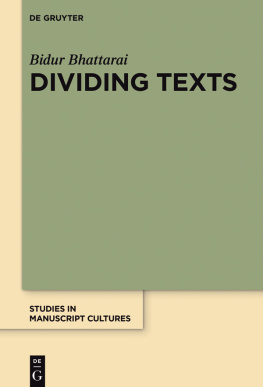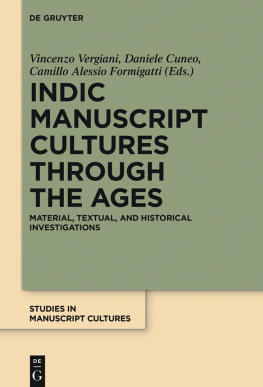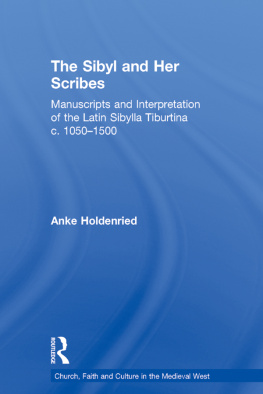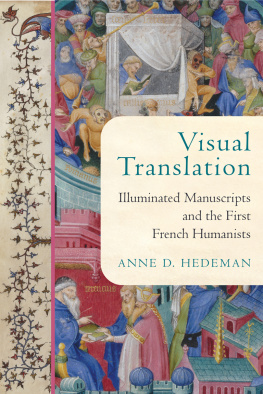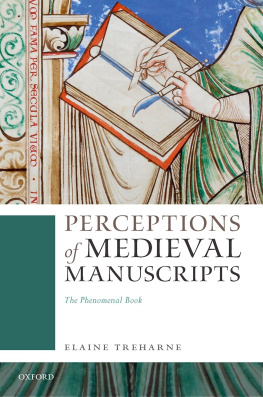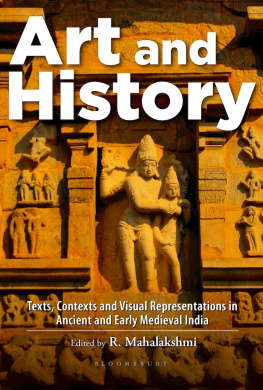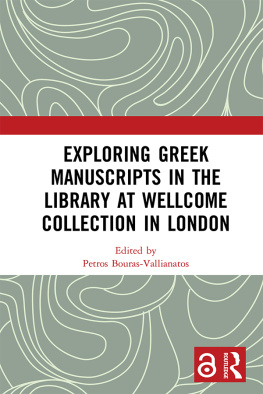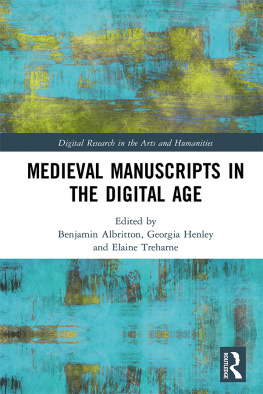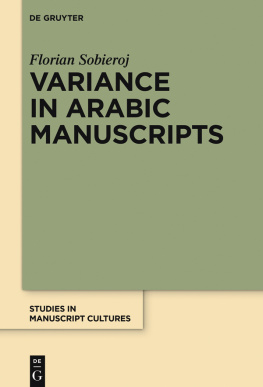Contents
Guide

Bidur Bhattarai
Dividing Texts
Studies in Manuscript Cultures

Edited by
Michael Friedrich
Harunaga Isaacson
Jrg B. Quenzer
Volume 10

ISBN 978-3-11-054307-0
e-ISBN (PDF) 978-3-11-054308-7
e-ISBN (EPUB) 978-3-11-054311-7
ISSN 2365-9696

This work is licensed under the Creative Commons Attribution-NonCommercial-NoDerivatives 4.0 License. For details go to http://creativecommons.org/licenses/by-nc-nd/4.0/.
Library of Congress Control Number: 2019915358
Bibliographic information published by the Deutsche Nationalbibliothek
The Deutsche Nationalbibliothek lists this publication in the Deutsche Nationalbibliografie; detailed bibliographic data are available on the Internet at http://dnb.dnb.de.
2020 Bidur Bhattarai, published by Walter de Gruyter GmbH, Berlin/Boston.
The book is published with open access at degruyter.com.
www.degruyter.com
Preface
This book is a revised version of my PhD dissertation, which was defended at the Centre for the Study of Manuscript Cultures (CSMC) of the University of Hamburg in January 2016. It is also the outcome of the sub-project Dividing Texts: Conventions of Visual Text-Organization in North Indian and Nepalese Manuscripts up to ca. CE 1350 (B04) of the Sonderforschungsbereich 950 Manuskriptkulturen in Asien, Afrika und Europa supported by the Deutsche Forschungsgemeinschaft (DFG) from 20112015.
The present volume focuses on the study of the visual organisation of manuscripts primarily from Nepal (particularly those originating in the Kathmandu Valley) and North-India (regions of Eastern, Western India), which were produced, largely on palm-leaves, between ca. 8001300 CE. However, a few examples of birch-bark and paper manuscripts as well as inscriptions from the same regions or other regions, prior or later, to the aforementioned time-frame are also included. Most of those examples not belonging to the core corpus of manuscripts analysed in this book have largely been recorded in the footnotes. Visual organisation is a significant aspect of any manuscript culture and its study helps obtain a broad knowledge of those artefacts, spanning from their production process to their usage. The study also takes into consideration the various techniques for dividing texts into sub-section and the practices used by scribes in the course of the manuscripts production, such as symbols, blank spaces, gaps, colours etc.
This book consists of six chapters. In the first chapter the introductory matters of the study are briefly mentioned providing notes on its methodology and the conventions that have been employed. The second chapter deals briefly with the overall layout of the manuscripts providing two examples for each manuscript from the core corpus that has been analysed. The third chapter, the most significant of this volume, studies the use of symbols found in manuscripts. Chapter four examines, in detail, the use of space(s) in manuscripts as dividing devices. Chapter five focuses on the use of colours followed by preliminary results from scientific examination of manuscripts. The examination of selected manuscripts was carried out in cooperation with scientists affiliated to the Project Area Z of the CSMC at the National Archives, Kathmandu in 2013. The sixth chapter discusses possible conclusions. The latter, however, are to be taken as preliminary findings, for many questions remain unanswered and call for further research.
A caveat is in order here as the number of manuscripts focused on in this study represents a mere fraction of the enormous corpora of manuscripts that may be deemed pertaining to Indic manuscript cultures. It is hoped this study will contribute some new insights into the studies of visual organisation and, possibly, inspire readers to undertake further research in the field. At the same time, remarks and suggestions may help improve the scope and content of this work.
Acknowledgements
This study could not have borne much fruit without various forms of support from numerous individuals, scholars, institutions, libraries, archives, etc. First and foremost, the work would have been impossible without the continuous support and invaluable supervision of Professor Dr Harunaga Isaacson (University of Hamburg). I wish to thank him very much not only for giving me the opportunity to work on the subject-matter of this book, but also for his constant support and encouragement during my work. His immense knowledge and guidance helped me at all stages of its research and throughout the books preparation.
I would also like to express my sincere gratitude to Prof. Dr Jrgen Hanneder (University of Marburg), who as second supervisor kindly examined my PhD dissertation. He too, showed constant interest in my research, provided motivation and insightful comments right up to the books completion. Furthermore, I would like to thank Prof. Dr Michael Zimmermann (University of Hamburg), one of the members of the examination committee of my PhD defence. His comments and suggestions were of great help in improving my work.
My sincere thanks also go to Prof. Dr Eva Wilden (University of Hamburg), who kindly granted me a three-month working contract in 2017 under the auspices of the NETamil project funded by the European Research Council (ERC). During which time, I was able to continue working on the books completion. Likewise, my heartfelt thanks go to the CSMC, especially Prof. Dr Michael Friedrich for the various short-term working contracts between 20162017 which permitted me to carry out further work on the book.
Furthermore, I would like to take this opportunity to thank my friend and colleague Dr Giovanni Ciotti (University of Hamburg). Always interested in my work, he provided remarkable feedback during my PhD, and was someone with whom I was able, not only to discuss many specific details, but also widen the horizons of my approach to manuscript studies.
This book would not have arrived at this form without the support of the editors of the Studies in Manuscripts Cultures series of the University of Hamburg, namely the aforementioned Prof. Dr Michael Friedrich, Prof. Dr Harunaga Isaacson and Prof. Dr Jrg B. Quenzer. I thank them all for granting me the opportunity of publishing the work in this series and most notably for their learned comments and suggestions.
I am also thankful to Dr Sebastian Bosch (University of Hamburg), Prof. Dr Oliver Hahn (University of Hamburg), Emanuel Kindzorra, and Prof. Dr Ira Rabin (University of Hamburg) for their generous support regarding the section on the scientific examination of manuscripts. In 2013, Prof. Hahn, Emanuel Kindzorra, and Prof. Rabin conducted the material analysis of certain manuscripts in Kathmandu, assisting me in making new discoveries on the materials used in manuscripts. Dr Bosch shared his valuable expertise with me when I was engaged in finalising the section on scientific examination. Furthermore, I would also like to take the opportunity to thank Karsten Helmholz, Christina Kaminski and Dr Irina Wandrey (CSMC) for their generous administrative assistance for the preparation of the research trip to Nepal in 2013 and the late Dr Albrecht Hanisch (Nepal Research Centre/Nepalese-German Manuscript Cataloguing Project) for his organisational help before and during our trip to Kathamandu.

